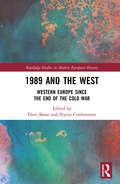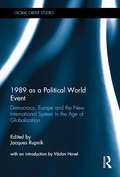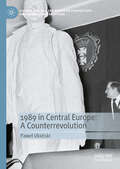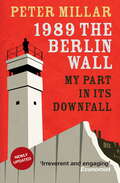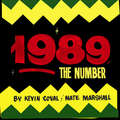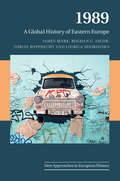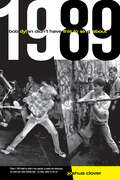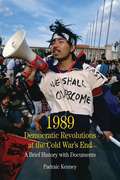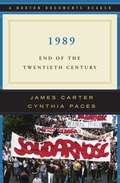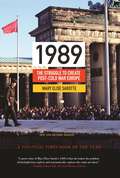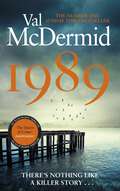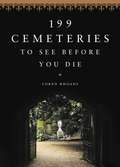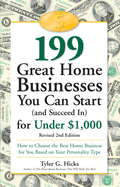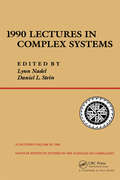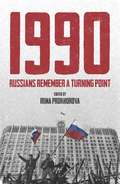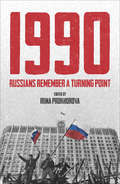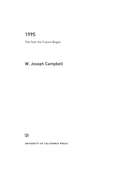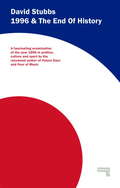- Table View
- List View
1989 and the West: Western Europe since the End of the Cold War (Routledge Studies in Modern European History)
by Eleni Braat Pepijn CorduwenerBack in 1989, many anticipated that the end of the Cold War would usher in the ‘end of history’ characterized by the victory of democracy and capitalism. At the thirtieth anniversary of this momentous event, this book challenges this assumption. It studies the most recent era of contemporary European history in order to analyse the impact, consequences and legacy of the end of the Cold War for Western Europe. Bringing together leading scholars on the topic, the volume answers the question of how the end of the Cold War has affected Western Europe and reveals how it accelerated and reinforced processes that shaped the fragile (geo-)political and economic order of the continent today. In four thematic sections, the book analyses the changing position of Germany in Europe; studies the transformation of neoliberal capitalism; answers the question how Western Europe faced the geopolitical challenges after the Berlin Wall came down; and investigates the crisis of representative democracy. As such, the book provides a comprehensive and novel historical perspective on Europe since the late 1980s.
1989 as a Political World Event: Democracy, Europe and the New International System in the Age of Globalization (Global Order Studies)
by Jacques RupnikThis book is not about the events of 1989, but about 1989 as a world event. Starting with the fall of the Berlin Wall and the collapse of the Soviet bloc it examines the historical significance and the world brought about by 1989. When the Cold War ended in Europe it ushered in a world in which the international agenda is set outside Europe, in America or Asia. The book critically examines and moves beyond some of the conveniently simple paradigms proposed in the nineties, by leading political scientists such as Fukuyama and Huntington, to show how the events of 1989 meant different things to different parties. This was an anti-utopian revolution, a symbol of the possibility of non-violent transitions to democracy, which raised the hopes of world-wide democratic changes. Contributors show how 1989 can be seen as the founding moment of a globalized world, but equal attention should be given to the dispersion of its meanings and the exhaustion of some of its main trends associated with the post-1989 era. Europe was reunited, yet it is in crisis. Twenty years on, global markets have brought about a global financial crisis. The fall of the Berlin Wall was celebrated as the advent of free movement in a world without borders. Now however, we can see that new borders, walls, fences have since been built. With an introductory essay by Vaclav Havel, 1989 as a Political World Event will be of interest to scholars of European Politics and International Relations.
1989 in Central Europe: A Counterrevolution (Central and Eastern European Perspectives on International Relations)
by Paweł UkielskiThe literature on the fall of communism contains numerous interpretations of the changes that took place in Central and Eastern Europe in 1989, while debates about how best to characterize the fall of the communist regimes have raged for many years. Researchers continue to ponder and argue over how ‘revolutionary’, as opposed to ‘evolutionary’ (or ‘reformatory’) these changes were. In this new study, author Paweł Ukielski proposes the term ‘counterrevolution’ to describe the historical process that took place and uses it as an analytical construct to better understand the crisis of Soviet communism and the subsequent transitions that took place.
1989 the Berlin Wall: My Part in Its Downfall
by Peter MillarFollow Peter Millar on a journey in the heart of Cold War Europe, from the carousing bars of 1970s Fleet Street to the East Berlin corner pub with its eclectic cast of characters who embodied the reality of living on the wrong side of the wall.
1989 the Berlin Wall: My Part in Its Downfall
by Peter MillarFollow Peter Millar on a journey in the heart of Cold War Europe, from the carousing bars of 1970s Fleet Street to the East Berlin corner pub with its eclectic cast of characters who embodied the reality of living on the wrong side of the wall.
1989, The Number
by Kevin Coval Nate Marshall1989, the number is an exploration of the year 1989 through politics, personal history and culture. This chapbook plays like a mixtape incorporating the hottest records and stories of 89 and reflecting their relevance for today.
1989: A Global History of Eastern Europe (New Approaches to European History #59)
by Tobias Rupprecht Ljubica Spaskovska James Mark Bogdan C. IacobThe collapse of the Berlin Wall has come to represent the entry of an isolated region onto the global stage. On the contrary, this study argues that communist states had in fact long been shapers of an interconnecting world, with '1989' instead marking a choice by local elites about the form that globalisation should take. Published to coincide with the thirtieth anniversary of the 1989 revolutions, this work draws on material from local archives to international institutions to explore the place of Eastern Europe in the emergence, since the 1970s, of a new world order that combined neoliberal economics and liberal democracy with increasingly bordered civilisational, racial and religious identities. An original and wide-ranging history, it explores the importance of the region's links to the West, East Asia, Africa, and Latin America in this global transformation, reclaiming the era's other visions such as socialist democracy or authoritarian modernisation which had been lost in triumphalist histories of market liberalism.
1989: Bob Dylan Didn't Have This to Sing About
by Joshua CloverIn a tour de force of lyrical theory, Joshua Clover boldly reimagines how we understand both pop music and its social context in a vibrant exploration of a year famously described as "the end of history." Amid the historic overturnings of 1989, including the fall of the Berlin Wall, pop music also experienced striking changes. Vividly conjuring cultural sensations and events, Clover tracks the emergence of seemingly disconnected phenomena--from grunge to acid house to gangsta rap--asking if "perhaps pop had been biding its time until 1989 came along to make sense of its sensibility." His analysis deftly moves among varied artists and genres including Public Enemy, N.W.A., Dr. Dre, De La Soul, The KLF, Nine Inch Nails, Nirvana, U2, Jesus Jones, the Scorpions, George Michael, Madonna, Roxette, and others. This elegantly written work, deliberately mirroring history as dialectical and ongoing, summons forth a new understanding of how "history had come out to meet pop as something more than a fairytale, or something less. A truth, a way of being."
1989: Democratic Revolutions At The Cold War's End - A Brief History With Documents (Bedford Cultural Editions)
by Padraic KenneyA series of democratic transformations in the 1980s ended the cold war and ushered in the present era. This volume by Padraic Kenney uses six case studies from this period — Poland, the Philippines, Chile, South Africa, Ukraine, and China — to explore common characteristics of global political change while highlighting the differing strategies and perspectives of the people who sought to free themselves from dictatorship. <p><p> A general introduction to the volume examines key trends in the decades leading up to the changes, tracing the paths that dictatorships and opposition movements took in their fateful confrontations. The first chapter with documents surveys the central ideas of this age of democratic, nonviolent revolution, and sets a framework for considering the case studies in the chapters that follow.
1989: End of the Twentieth Century (A Norton Documents Reader)
by James Carter Cynthia Paces1989: End of the Twentieth Century offers a comparative look at one of the most eventful years in world history. Nineteen eighty-nine marked the end of the Cold War, the fall of the Berlin Wall, the end of apartheid, and the "Beijing Spring" protests in Tiananmen Square. This engaging reader focuses on critical questions like "Why was the world caught by surprise by these events?" and "Why did the revolutions in Eastern Europe and in South Africa end in jubilation, while the protests in China ended in tragedy?" The original essay and the rich collection of documents in this volume explore both the long-term trends an the immediate causes that led to this series of events in 1989 that changed the world forever.
1989: The Struggle to Create Post-Cold War Europe - Updated Edition (Princeton Studies in International History and Politics #147)
by Mary Elise SarotteHow the political events of 1989 shaped Europe after the Cold War1989 explores the momentous events following the fall of the Berlin Wall and the effects they have had on our world ever since. Based on documents, interviews, and television broadcasts from Washington, London, Paris, Bonn, Berlin, Warsaw, Moscow, and a dozen other locations, 1989 describes how Germany unified, NATO expansion began, and Russia got left on the periphery of the new Europe.This updated edition contains a new afterword with the most recent evidence on the 1990 origins of NATO's post-Cold War expansion.
1989: The brand-new thriller from the No.1 bestseller (Allie Burns)
by Val McDermidTHE SECOND THRILLING NOVEL IN VAL MCDERMID'S NEW SUNDAY TIMES BESTSELLING SERIESThere's nothing like a killer story . . . 1989. The world is changing, and Allie Burns is still on the front line, covering the stories that count.Although Allie is no longer an investigative journalist, her instincts are sharper than ever. When she discovers a lead about the exploitation of society's most vulnerable, Allie is determined to give a voice to those who have been silenced. As Allie edges closer to exposing the truth, she travels behind the Iron Curtain, to East Berlin on the brink of revolution. The dark heart of the story is more shocking than she ever imagined. And to tell it, Allie must risk her freedom and her life . . . The latest Allie Burns thriller, set a decade after the bestselling first novel in the ground-breaking, iconic new series.Praise for 1979'McDermid is at her considerable best' GUARDIAN'Irresistible' PATRICIA CORNWELL'A brilliant novel by a supremo of the genre' PETER JAMES'Outstanding' SPECTATOR'Another masterpiece' DAVID BALDACCI'Sensational. One of Britain's most accomplished writers' SUNDAY EXPRESS
199 Cemeteries to See Before You Die
by Loren RhoadsA hauntingly beautiful travel guide to the world's most visited cemeteries, told through spectacular photography and their unique histories and residents. More than 3.5 million tourists flock to Paris's Père Lachaise cemetery each year. They are lured there, and to many cemeteries around the world, by a combination of natural beauty, ornate tombstones and crypts, notable residents, vivid history, and even wildlife. Many also visit Mount Koya cemetery in Japan, where 10,000 lanterns illuminate the forest setting, or graveside in Oaxaca, Mexico to witness Day of the Dead fiestas. Savannah's Bonaventure Cemetery has gorgeous night tours of the Southern Gothic tombstones under moss-covered trees that is one of the most popular draws of the city. 199 Cemeteries to See Before You Die features these unforgettable cemeteries, along with 196 more, seen in more than 300 photographs. In this bucket list of travel musts, author Loren Rhoads, who hosts the popular Cemetery Travel blog, details the history and features that make each destination unique. Throughout will be profiles of famous people buried there, striking memorials by noted artists, and unusual elements, such as the hand carved wood grave markers in the Merry Cemetery in Romania.
199 Flags: Shapes, Colors, and Motifs from Around the World
by Orith KolodnyJourney around the world through 199 flags! This striking visual book explores the shapes, figures, and colors of flag design. Whether a national flag features vertical stripes or horizontal ones, two colors or more, symbols drawn from nature or from history—each detail of its design is intentional and loaded with meaning. Graphic designer Orith Kolodny demystifies the recurring colors and visual components of national flags. Through the study of flag design, this book shows that countries with vastly different climates and cultures often have more in common than one might expect. This book is:• Organized by design rather than geography• Divided into categories such as stripes, diagonal lines, triangles, circles, crosses, and natural forms (like suns, moons, stars, and trees)• A stylish introduction to the iconography of independence199 Flags explores the meaning behind each flag in an entertaining and accessible way. Through a captivating combination of design theory and world history, you'll learn how to decode the symbols and interpret shapes of flags through a designer's eye.• A perfect gift for dads, designers, travelers, geography nerds, and history buffs • Learn about our world in a unique way that prioritizes design and meaning over rote memorization.• Great for fans of Logo Design Love: A Guide to Creating Iconic Brand Identities by David Airey, The Design of Everyday Things by Don Norman, Flags of the World by Sylvie Bednar, and Draplin Design Co. by Aaron James Draplin
199 Great Home Businesses You Can Start (and Succeed In) for Under $1,000: How to Choose the Best Home Businesses for You Based on Your Personality Type
by Tyler G. HicksTurn Your Dream of Starting a Home-Based Business into Reality! It's incredibly easy to start a money-making business right from the comfort of your own home. Millions of people just like you are enjoying the freedom—and extra income—of working for themselves. You can too. In 199 Great Home Businesses You Can Start (and Succeed In) for Under $1,000, home-based business guru Tyler Hicks shows you how to achieve your work-at-home dream. Inside you'll learn the secrets to: ·Choosing the home-based business that's just right for you ·Getting started in your business with minimal cost ·Building your fortune doing what you love ·Running a business from home while keeping your day job ·Using the Internet to advertise and promote your home-based business ·And much more! This invaluable book will help you begin your promising new life today as a successful home-based entrepreneur! <P><P><i>Advisory: This book offers only partial accessibility. We have kept it in the collection because it is useful for some of our members. Benetech is actively working on projects to improve accessibility issues such as these in the future.</i>
1990 Lectures In Complex Systems
by Lynn Nadel Daniel I. SteinAn excellent series presenting top lecturers from the best institute for complex systems. Topics covered include: stochastic processes; fluid flow; pattern formation; information-based complexity; motor system problems; and the nature of adaptive change.
1990-2000: The Electronic Age, North American Edition (20th Century Science and Technology)
by Steve Parker20th Century Science and Technology is a decade-by-decade account of scientists and their breakthroughs, inventors and their inventions that have shaped the modern world.
1990: Russians Remember a Turning Point
by Arch Tait Irina ProkhorovaAlthough 1989 and 1991 witnessed more spectacular events, 1990 was a year of embryonic change in Russia: Article 6 of the constitution was abolished, and with it the Party's monopoly on political power. This fascinating collection of documentary evidence crystalises the aspirations of the Russian people in the days before Communism finally fell. It charts - among many other social developments - the appearance of new political parties and independent trade unions, the rapid evolution of mass media, the emergence of a new class of entrepreneurs, a new openness about sex and pornography and a sudden craze for hot-air ballooning, banned under the Communist regime. 1990 is a reminder of the confusion and aspirations of the year before Communism finally collapsed in Russia, and a tantalising glimpse of the paths that may have been taken if Yeltsin's coup had not forced the issue in 1991.
1990: Russians Remember a Turning Point
by Arch Tait Irina ProkhorovaAlthough 1989 and 1991 witnessed more spectacular events, 1990 was a year of embryonic change in Russia: Article 6 of the constitution was abolished, and with it the Party's monopoly on political power. This fascinating collection of documentary evidence crystalises the aspirations of the Russian people in the days before Communism finally fell. It charts - among many other social developments - the appearance of new political parties and independent trade unions, the rapid evolution of mass media, the emergence of a new class of entrepreneurs, a new openness about sex and pornography and a sudden craze for hot-air ballooning, banned under the Communist regime. 1990 is a reminder of the confusion and aspirations of the year before Communism finally collapsed in Russia, and a tantalising glimpse of the paths that may have been taken if Yeltsin's coup had not forced the issue in 1991.
1990: Russians Remember a Turning Point
by Irina ProkhorovaAlthough 1989 and 1991 witnessed more spectacular events, 1990 was a year of embryonic change in Russia: Article 6 of the constitution was abolished, and with it the Party's monopoly on political power. This fascinating collection of documentary evidence crystalizes the aspirations of the Russian people in the days before Communism finally fell.It charts--among many other social developments--the appearance of new political parties and independent trade unions, the rapid evolution of mass media, the emergence of a new class of entrepreneurs, a new openness about sex and pornography and a sudden craze for hot-air ballooning, banned under the Communist regime.1990 is a reminder of the confusion and aspirations of the year before Communism finally collapsed in Russia, and a tantalizing glimpse of the paths that may have been taken if Yeltsin's coup had not forced the issue in 1991.
1991 How P. V. Narasimha Rao Made History: How P.v. Narasimha Rao Made History
by Sanjaya BaruP. V. Narasimha Rao (or PV as he was popularly known) has been widely praised for enabling the economic reforms that transformed the country in 1991. From the vantage point of his long personal and professional association with the former prime minister, bestselling author Sanjaya Baru shows how PV’s impact on the nation’s fortunes went way beyond the economy. This book is an insider’s account of the politics, economics and geopolitics that combined to make 1991 a turning point for India. The period preceding that year was a difficult one for India: economically, due to the balance of payments crisis; politically, with Rajiv Gandhi’s politics of opportunism and cynicism taking the country to the brink; and globally, with the collapse of the Soviet Union, its ally. It was in this period that the unheralded PV assumed leadership of the Indian National Congress, took charge of the central government, restored political stability, pushed through significant economic reforms and steered India through the uncharted waters of a post-Cold War world. He also revolutionized national politics, and his own Congress party, by charting a new political course, thereby proving that there could be life beyond the Nehru-Gandhi dynasty. 1991 marked the end of an era and the beginning of another. It was the year that made PV. And it was the year PV made history.
1994-95 Mexican Peso Crisis
by Kenneth A. Froot Matthew McbradyExplores the peso crisis of 1994-95 and why it occurred. Students must examine Mexico's policies, the capital market's reactions, and the implications of devaluation for future capital flows and growth.
1995
by W. Joseph CampbellA hinge moment in recent American history, 1995 was an exceptional year. Drawing on interviews, oral histories, memoirs, archival collections, and news reports, W. Joseph Campbell presents a vivid, detail-rich portrait of those memorable twelve months. This book offers fresh interpretations of the decisive moments of 1995, including the emergence of the Internet and the World Wide Web in mainstream American life; the bombing at Oklahoma City, the deadliest attack of domestic terrorism in U.S. history; the sensational "Trial of the Century," at which O.J. Simpson faced charges of double murder; the U.S.-brokered negotiations at Dayton, Ohio, which ended the Bosnian War, Europe's most vicious conflict since the Nazi era; and the first encounters at the White House between Bill Clinton and Monica Lewinsky, a liaison that culminated in a stunning scandal and the spectacle of the president's impeachment and trial. As Campbell demonstrates in this absorbing chronicle, 1995 was a year of extraordinary events, a watershed at the turn of the millennium. The effects of that pivotal year reverberate still, marking the close of one century and the dawning of another.
1996 And The End of History
by David Stubbs1996 And The End of History examines the year as it panned out in the UK not just in politics but in music, light entertainment and sport. It was the zenith of a decade which will go down as remarkably untroubled bymodern standards; following the collapse of the Berlin Wall, prior to 9/11, in which political conditions of peace and apparent economic prosperity created an overall mood of frivolity, postmodern anti-seriousness and a desire to get back to sunnier times before the grim onset of the strife-ridden 70's and 80's.
1996 Welfare Reform in the United States
by Matthew C. Weinzierl Katrina Flanagan Alastair SuOn August 22, 1996, U.S. President Bill Clinton signed into law the Personal Responsibility and Work Opportunity Reconciliation Act (PRWORA)-a dramatic reform of the American system of economic assistance for the poor that, as its title suggested, attempted to encourage labor force participation rather than reliance on federal support. Clinton's decision to support a proposal that substantially cut spending on economic assistance was controversial among members of the Democratic Party, especially so close to the 1996 election. Republicans, in contrast, hailed the signing of PRWORA. Was the 1996 welfare reform a triumph of centrist policymaking that would establish a more sustainable version of economic assistance for poor Americans, or was it a dangerous first step toward the gradual disappearance of that assistance? Whose vision of American society did it represent? Instructors may also obtain a Teaching Note, written by this case's author, that provides suggestions for using this case effectively in the classroom.
